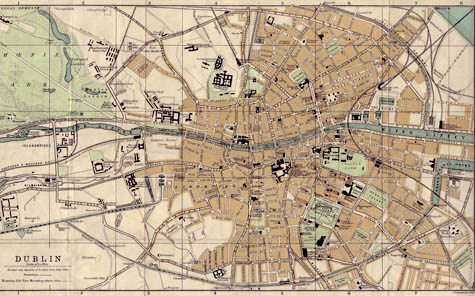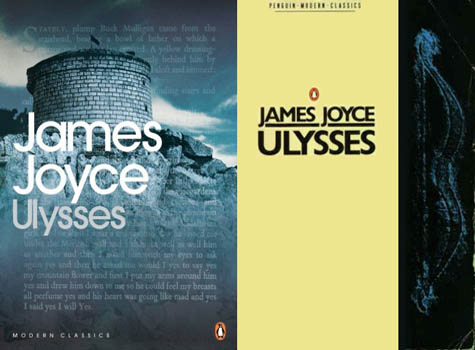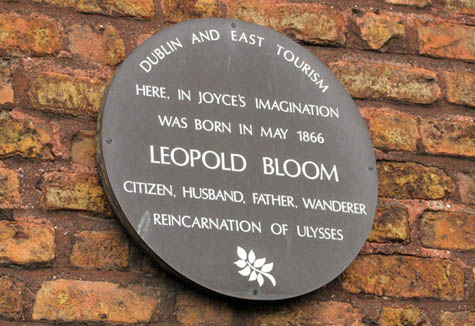BLDGBLOG (2)
By:
July 26, 2010
Bloomsday
Yesterday, as James Joyce fans will know, was Bloomsday: June 16th. The day Leopold Bloom made his famous walk around Dublin in Joyce’s 1922 novel Ulysses.
 [Image: Street map of Dublin].
[Image: Street map of Dublin].
Ulysses — considered something of the ultimate in literary modernism, as much for its mythical remaking of everyday life as for its often impenetrable abstraction, presaging Joyce’s later linguistic kaleidoscope, Finnegan’s Wake — was, for me, utterly transformed as a novel when my brother suggested that it was actually an attempt at descriptive realism.
That is, should you want to describe a man’s walk around the city in as detailed and realistic a way as possible, capturing every minor event and instant, then you would have to include the circumstances of that walk in their often bewildering totality: every fragmentary thought process, directionless flight of fancy, and irrelevant detail noticed along the way, via a million and one dead-ends. Things remembered and then forgotten. Deja vu.
That daydream you had early today? That was, Ulysses suggests, part of the infrastructure of the city you live in.
The city here becomes a kind of experiential labyrinth: it is something you walk through, certainly, but it is also something that rears up mythically to consume the thoughts of everyone residing within it.
To say that Ulysses, then, is one of the most realistic urban novels ever written surely sounds like a joke to anyone not connected to academia — yet, once the apparent absurdity of such a statement wears off, it seems utterly ingenious.
After all, how do you map the city down to its every last conceivable detail? And what if cartography is not the most appropriate tool to use?
What if narrative — endlessly diverting narrative, latching onto distractions in every passing window and side-street, with no possible conversation or observation omitted — is the best way to diagram the urban world?
In such a constellated wealth of minor points, “realism” becomes a useless haze — like listening to every conversation at a party simultaneously. And that’s before you add internal monologues and descriptive details from the pubs and sidewalks all around you.
In any case, there are many secondary points to make here. For instance, I’d actually suggest that the narrative position just outlined actually describes not a person at all but a surveillance camera — that is, the Ulysses of the 21st century would actually be produced via CCTV: it would be Total Information Awareness in narrative form.
 But the whole point of this post was actually to ask two things:
But the whole point of this post was actually to ask two things:
1) What if Ulysses had been written before the construction of Dublin? That is, what if Dublin did not, in fact, precede and inspire Joyce’s novel, but the city had, itself, actually been derived from Joyce’s book?
At the very least, this would be an awesome proposition for a design studio: read Ulysses and then design the city it describes… The differing responses would be fascinating.
Further, this raises the question of whether a city has ever been built, directly inspired by a work of fiction. Of course, you could stretch the term fiction a bit, and say that those fundamental fictions of a nation’s founding myths might have inspired a city — or an historic preservation district — or perhaps you could even say, as if channeling Michael Sorkin, that the city’s zoning code is itself a monumental act of narrative modernism.
But what about an actual novel? If you can take, say, Moonraker by Ian Fleming and turn it into a film — that is, Moonraker, directed by Lewis Gilbert — then could you also take a novel — here, Ulysses — and turn it into a city?
2) If you fed Ulysses into a milling machine — that is, if you input not a CAD file but a massive Microsoft Word document containing the complete text of Ulysses — what might be the spatial result? Would the streets and pubs and bedrooms and stairwells of Dublin be milled from a single block of wood?
What if you fed Ulysses through a 3D printer?
Oddly, I’m reminded here of something that has long fascinated me: quipu, the so-called knot language of the Inca. Quipu, to make a very long story short, is a way of braiding strands of animal hair or colored yarn together, using specific types of knot; these knots, arrayed in specific orders, thus communicate things to others — whether that’s accounting information or perhaps even cultural myths. It was a form of writing, although its words were 3D shapes.
As a brief aside, the possible paranoias of a quipu translator have always seemed particularly stunning to me: for instance, someone over-immersed in the world of Andean knot-languages becomes convinced that, in the drooping symmetry of a basketball net or in the shoelaces of strangers walking past on the street, there might be written messages: epic poems, secret codes, unintended diary entries.
Instead of Freudian dream-analysis, you perform quipu knot-analysis, even examining the micro-fibers of strangers’ clothing for hidden meanings… (It’s worth mentioning that this exact idea actually appears in the unwatchably bad film Wanted).
In any case, I mention quipu here because I can’t even believe how cool it would be if 3D printers might someday be used to create word-objects: little amorphous and abstract three-dimensional shapes that aren’t just works of art, they are a new form of writing.
Like quipu, they are 3D linguistics: words in space.
The idea here that all those high-end design items you see lining the shelves of boutique shops in downtown Milan or Moscow or Manhattan are actually strange new, highly literal forms of communication, makes the mind reel.
Spy films of the future! MI6’s man in Havana goes into a specialty cookware shop where the salt and pepper shakers are not at all what they seem…
Or, inspired by Alfred Hitchcock, the FBI begins leaving little figurines in empty hotel rooms, knowing that the next guest will be an undercover informer — and those abstract statuettes left behind in the cupboard actually encode the next location of rendezvous…
And so on.
So the point of this long tangent is this: if you fed Ulysses through a 3D printer, what might the resulting shapes be?
What if the unexpected blobs and shapes could be considered a translation of the novel?
 [Image: Historical maker for the birthplace of Leopold Bloom in Dublin].
[Image: Historical maker for the birthplace of Leopold Bloom in Dublin].
Inspired by Bloomsday, then, it seems well-timed to ask not only how our cities can best be mapped — and if narrative is, in fact, the ideal cartographic strategy — but what other physical possibilities exist for narrative expression. Put another way: what if James Joyce had been raised in an era of cheap 3D printers?
After all, given the possibilities outlined above, we might even someday be justified in concluding that Dublin itself is a written text, and that Ulysses is simply its most famous translation.
We’ve described Geoff Manaugh’s BLDGBLOG “our favorite history/urban exploration/science fiction/design/climate change/city planning blog.” So we’re delighted to present a curated series of 10 BLDGBLOG posts. This is the series’ second installment.
